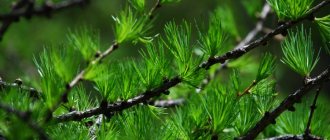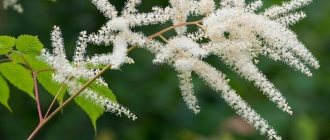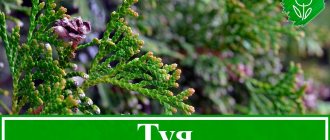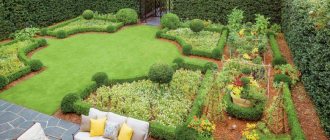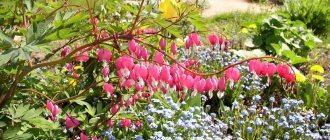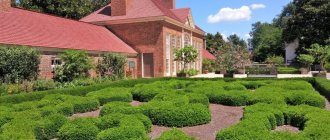Tip 1: How to grow larch
Larch is the only deciduous, but at the same time coniferous tree in the nature of the central zone of our country. A fabulous larch planted in a dacha will create a romantic atmosphere in the garden. These trees are the most unpretentious of the northern latitude conifers; they grow well even on city streets. The main thing that larches do not like is stagnation of water in the ground.
You will need
- - cones;
- - boxes;
- - a mixture of leaf soil, peat and sand;
- — kraft paper;
- — fertilizers and mushrooms;
- — insecticidal preparations based on mineral oils.
Instructions
- Larches are propagated by seeds. At the end of autumn, you need to collect fresh cones and put them in a dry, dark place. There the cones will open, releasing the seeds. It is best to sow them before winter in light soil. You should take large boxes, because the trees will spend a couple of years in them.
- In spring, the boxes should be placed in the sun and watered regularly. At the age of one or two years, larches can be moved to a permanent place. The optimal planting period is autumn after leaf fall or spring before the first leaves appear. The distance between trees should be from two to four meters. Planting depth - 70-80 cm.
- It is better to plant larch in a sunny place. The tree is not demanding on the soil (the only point is that it grows slowly on sandy soil). Gardeners recommend planting larches in a mixture of leaf soil, peat and sand (3:2:1).
- The soil under young trees should be loosened. In the first two years after planting, in winter and early spring, young larches should be covered with craft paper.
- In early spring, fertilizers must be added to the soil. In summer, it is important to carefully remove weeds. In hot weather, larch needs to be watered 1-2 times a week, using 15–20 liters of water for each tree. Water after wild mushrooms have been washed in it is especially useful. You can also bury worm-worm mushrooms near larches.
- It is worth carefully monitoring the appearance of pests such as larch leaf miner. When affected by moths, the needles lighten and become flabby. In this case, it is necessary to cut off the diseased branches and treat the trees with a solution of any insecticidal preparation made on the basis of mineral oils. The pine bug is also dangerous.
- KakProsto.ru
What to look for when buying seedlings
How to grow larch?
There are two ways - seedlings or seeds. Seedlings must be two to four years old. It is better to purchase plants in containers. When purchasing, pay attention to the tips of the needles - they should not be dry. The branches should bend, not lean to the sides.
However, sometimes it is quite difficult to buy larch seedlings. Therefore, it is often sown with seeds, which are extracted independently from the cones at the end of October or purchased in specialized stores. Before planting, they must be stored in a paper bag. Seeds remain viable for two to three years.
European larch
Botanical name: European larch
Homeland of European larch: Western and Northern Europe
Lighting: photophilous
Soil: dry, calcareous, black soil, does not tolerate waterlogging
Watering: rare
Maximum tree height: 30-50 m
Average lifespan of a tree: 500 years
Planting: grafting
Description of European larch with photo
European larch (lat. Larix decidua) is a type of coniferous tree belonging to the Pine family. Natural habitat is the highlands of the Alps and Carpathians (from 1000 to 2500 m above sea level). In nature, it is most often found in mixed forests in the vicinity of European cedar, mountain pine, spruce, white fir, and forest beech. In the undergrowth there may be coexistence with coarse or rusty rhododendron or common juniper.
European larch, the photo of which is presented above, grows successfully on shale, crystalline rocks, as well as on undeveloped, podzolic soils. These trees are characterized by amazing longevity - they often live for more than half a century, reaching 50 or more meters in height.
The botanical description of European larch is similar to the description of all trees of the Pine family. In youth, it has a trunk diameter of 80 to 100 cm; with age, the trunk diameter of European larch (larix decidua) can reach 150 cm.
The crown of trees of this species is cone-shaped, sometimes irregular in shape. The bark in the inner layers is red-brown, the outside is brown or gray-brown. The thickness of the bark reaches 2-4 cm.
European larch (see photo) is quite wind-resistant due to its deep root system.
Larix decidua cones are ovoid-conical or oblong-ovoid in shape, reaching a length of up to 6 cm. The color of young cones is purple; when ripe, they become brownish. The scales on the cones are arranged in 6-8 rows, open in the spring the next year after ripening and fall off after 3-5 years. Often new shoots sprout from the cones.
The seeds of European larch (larix decidua) are oval in shape, quite large, reaching a length of 4 mm. One kilogram contains up to 135,000 seeds. Trees bear fruit every 3-5 years.
The wood of European larch (see photo) is resinous, hard, and practically not subject to rotting. In industry, the red core is most valued; it is used as a building material for water and other structures.
Varieties of European larch
During breeding, many varieties of European larch were developed, differing in crown shape, spikelet color, cone size and scale size.
European larch "Pendula"
European larch "Pendula" is a tree with a semi-recumbent trunk, rising upward, and branches hanging down to the ground.
“Pendula” is a weeping form, characterized by a bluish tint of needles. European larch "Pendula" was discovered about 200 years ago and immediately became popular, mainly due to its beautifully flowing shoots.
The weeping form of European larch in nature reaches 25-30 m in height, which limited its scope for quite a long period of time. Later, smaller forms began to be developed.
The variety "Pendula" is propagated by grafting, which allows one to obtain trees of various sizes. The needles of Pendula larch are soft, delicate, have a light green color in summer, and become golden yellow in autumn.
Trees of this variety are light-loving and frost-resistant, and are widely used on a retaining wall, as a tapeworm on a lawn, an alpine hill, in Japanese, heather and rocky gardens.
European larch “Puli” (Puli)
European larch “Puli” is a decorative dwarf form with a weeping crown formed by graceful drooping branches. The height of trees of this variety reaches no more than 2 meters, which increases the frequency of their use for decorative purposes. European weeping larch of the "Puli" form has grey-blue-green needles on low-hanging branches. In autumn, like the Pendula trees, Puli needles turn yellow-gold.
European larch “Puli” prefers alkaline, fertile soils, like all weeping forms - it is quite light-loving. These trees are winter-hardy and frost-resistant, despite their visual elegance. For normal development, plants need a large amount of free space; neighboring plantings should be located at a considerable distance. This form is used mainly in stylized gardens or as a tapeworm on lawns.
European larch "Kornik"
European larch “Kornik” is a coniferous shrub. This variety of plants of the Pine family has a spherical crown with bright, rich green needles. The height of these trees usually does not exceed 2 m. The branches of the Kornik bush are dense, short, and pointing upward. Even in winter, the European larch “Kornik”, the photo of which is located below, does not lose its decorative effect. The shrub is quite frost-resistant, but in winter, especially if the winter has little snow, it is necessary to ensure that the roots are not damaged. To do this, it is best to cover the tree trunk circle with spruce branches.
Having a fairly modest size, these trees are wind-resistant and survive well in city conditions. Widely used in panoramic compositions or as one of the elements in contrasting plantings with multi-textured architecture. Young plants of this variety lend themselves well to shaping, but as they age, cutting is unsafe.
European larch "Repens"
European larch “Repens” is a form of trees with shoots creeping along the ground. The height of this variety depends on the grafting. As you can see in the photo, European larch “Repens” reaches no more than 1-1.5 in height. Just like all other varieties of larch, this form is light-loving and winter-hardy. Repens needles are collected in bunches, which distinguishes it from other trees of the Pine family. In spring the needles are light green, in autumn the color changes to brownish-yellow. As winter approaches, the needles fall off.
European larch "Repens" grows well in nutritious, moist soils, but does not tolerate waterlogging. Caring for these trees is not difficult. This variety is recommended for use in small and rocky Japanese gardens; the Repens form is also suitable for growing in containers. With all the variety of choice, the variety “Repens” is found in plantings of the Central Russian strip more often than others.
Photo gallery: European larch (click on the image to enlarge):
udec.ru
Landscape compositions with fir trees
Spruce is the favorite tree of many landscape designers. It is suitable for any style of landscape design. She is loved for her majestic, evergreen beauty. An adult tree becomes an accent in the composition and a place of attraction on the site.
In landscape design, low-growing and medium-growing species that do not grow higher than 15 m are most often used.
A separate tree (solitaire), planted on the site in front of the house, will become the best New Year's tree that you can dress up and dance around it. Tall spruce trees are excellent for solitaire planting in open areas and lawns.
Dwarf spruce species can be planted in rock gardens and rock gardens.
Medium-sized species are excellent for hedges.
Dwarf varieties fit well into mixborders and any flower arrangement where a variety of types of shrubs and flowers are present.
You can create a shady alley from spruce. Planted spruce trees along the path will protect from the winds and create shade on sunny days. In addition, a certain microclimate is created in such a tunnel; the air is filled with beneficial phytoncides and essential oils. Walking through this tunnel every day, we receive the therapeutic effect of spruce aromatherapy.
Spruce trees with a weeping crown add variety to the landscape composition and go well with other varieties of spruce trees.
The dense crown of spruce allows little light to pass through; this feature can be used when designing recreation areas and to cover unsightly places in the garden.
Combination with other plants
Plants with bright flowers will look beautiful next to a green spruce. For example, roses, tulips, rhododendrons. Hydrangea goes well with spruce trees, both blue and green.
Spruce trees with blue needles go well with other types of spruce trees and conifers. A planted spruce tree near the pool emphasizes the blueness of the water and creates a harmonious color ensemble.
Perennials and various shrubs stand out very beautifully against a uniform background of pine needles.
Pines, spruces, thujas, junipers, spirea and Kuril tea look good together and create a landscape composition of various shades of green. The space between the plantings is mulched with pine bark, hiding the automatic watering system and making the space unified and complete. Against the background of a green wall of thujas, a spruce with a weeping crown and blue needles stands out. A dwarf form of spruce with yellow needles was planted next to it.
By using spruce trees with different colored needles in the composition, we enliven it and add a unique flavor. We constantly want to look at plants and observe them.
IMPORTANT
Due to the fact that the soil under the spruce canopy is depleted and acidic, few plants will be able to survive and develop normally there. But there are still some who tolerate such proximity well. Under the spruce and near the tree trunk you can plant:
- lilies of the valley,
- sorrel,
- astilbe,
- various types of ferns.
Do-it-yourself cellar: sequential construction instructions
At the dacha, many objects and buildings can be built that will make work and life easier, but one of them is the main one, and it needs to be built in the near future. Today we will talk about how to build a cellar with your own hands, and how to simplify this process as much as possible. A cellar structure is necessary for...Popular aquatic plants for a pondTulips: recommendations for growing and caringA practical greenhouse for seedlings with your own handsHow to make a dry stream with your own handsModern methods of growing potatoes: warm beds, under straw, in a barrelBarberry is a magnificent ornamental shrub with a lot of useful propertiesDiseases and pests, that affect bonsaiRestoration and complete renovation of garden paths Fir - cultivation and care, beneficial properties
Fine-scaled larch: features of planting and care
Larch is an elegant decoration for your garden. Outside the window, the autumn sun is still shining, half of the leaves have not yet fallen from the trees, but soon autumn will exceed half of the time allotted to it by nature and winter will inevitably come. But what will decorate your garden and indeed the landscape surrounding your house in winter, when all deciduous plants - trees and shrubs - lose their green attire? That’s right, decorative coniferous trees will become such a decoration.
Content:
- Types of fine-scaled larch
If your goal is not to grow potatoes in the area around your country house, but simply want to create a garden landscape pleasing to the eye, then coniferous plants, which do not require special care either in winter or in summer, will become the basis for your garden. There is simply no alternative to them.
They are very unpretentious, immune to most plant diseases, do not need fertilizing or weeding, are incredibly diverse and beautiful all year round.
Among ornamental coniferous trees, fine-scaled larch occupies a special place.
Distribution and ecology
This tree is endemic to the Japanese island of Honshu, i.e. its natural habitat was limited to this island. Hence the origin of another of its names - Japanese larch. In nature, the tree grows in large homogeneous tracts in the mountain forest belt at an altitude of at least 1600 m above sea level. At lower altitudes, solitary larches are found, preferring oaks, beeches and hornbeams as neighbors. In its homeland, this type of larch has been cultivated for a very long time and is a traditional object of the art of bonsai - the technique of growing a miniature copy of a real tree.
Larch looks great both on its own and in group plantings
Japanese larch is well adapted to cold and dry climates and is resistant to late spring frosts. Among all larch species, it tolerates shade best. Cultivated trees grow successfully on podzolic soils and chernozem, but feel best on fresh and thick layers of clay and sandy soils.
Benefits of culture
Let's consider the advantages of weeping coniferous crops:
- Rapid growth - a couple of years after planting a young seedling, you will receive a luxurious adult tree.
- Durability – with proper care, larch grows for a long time.
- Unpretentiousness - even a beginner can cope with the task of growing crops.
- Attractive appearance - larch always looks luxurious and is an excellent decoration for the garden and local area.
The tree also absorbs harmful substances, withstands frost normally, and grows on any soil and in all Russian regions. Its wood is used in the production of furniture and construction work.
Description of Japanese larch
This type of larch has slightly twisted branches and reddish-brown fissured bark that differ from its other species. Over the course of a year, the tree grows 25 cm high and 10−15 cm wide. It bears fruit from the 15th to 20th year of life. The thick and long branches of this beautiful tree are located almost horizontally and create a crown shaped like a wide pyramid.
Larch is used for landscaping both in winter gardens and in open ground
Japanese larch often has a trunk with many peaks, its red-brown bark is not too thick. Young shoots have reddish bark covered with a bluish coating. The buds are dark brown, shiny, the needles are blue-green, up to 5 cm long.
This tree has a number of features due to which dachadecor.ru recommends using this plant to landscape your patio:
- In autumn, the needles of this larch acquire a bright yellow tone much later than the needles of other species of larches, due to this, Japanese larch looks in landscape compositions as a bright, eye-catching spot.
- The cones of the tree are spherical, yellowish-green in color, with leathery and thin scales, bent back like rose petals. The cones can remain on the branches for up to three years, forming small light brown seeds.
- These trees are resistant to low temperatures, but are picky about soil composition. They develop well in city conditions.
- Rapid growth and frost resistance have led to the widespread use of Japanese larch as an element of landscape compositions, as well as landscape design in the form of single plantings.
- In terms of decorative properties, this larch has good compatibility in plantings with pine, spruce, juniper, as well as linden, ash, oak and many other plants. So, in terms of its ability to harmoniously combine with other plants, this tree is universal.
Substrate
Uncultivated larches are absolutely unpretentious to the composition and structure of the soil. They grow well in highly acidic and alkaline soils. But this only applies to wild trees.
Planting material that is propagated indoors is very delicate and may simply not survive in such soil. To avoid this, special soil is prepared for larch. When planting in open soil, drainage made of expanded clay or pebbles is initially installed at the bottom of the hole. Seedlings are sensitive to excess water and may die. Reproduction of young animals and good development is possible when grown in loamy substrates with medium or weak acidity and good oxygen saturation.
Planting and caring for fine-scaled larch
Planting and caring for larch is carried out with the arrival of early spring; this tree needs early alienation. Trees should be planted in a permanent place as early as possible - the best age for this is 1-2 years. The most favorable period for planting is in early spring, even before the buds open, or in the fall, immediately after the leaves fall.
You need to buy larch from reliable stores or farms
The gaps between trees should be at least 2-4 meters. As landing sites, you should choose areas open to sunlight, but slight shading is also possible.
The tree has a branched and deep root system, providing it with high wind resistance. The planting procedure and technology for caring for Japanese larch are not too complicated; it is only important not to damage the mycorrhiza located on the thin roots. It is recommended to plant trees at a depth of 70-80 cm.
The soil mixture should include leaf soil, peat and sand in a ratio of 3:2:1. In heavy clay soils, drainage should be provided. In this case, a 20 cm layer of broken brick is laid at the bottom of the planting hole.
Larch will become an “accent” in your garden, both in summer and winter
Young seedlings can be harmed by summer drought. During this period, they should be watered twice a week, spending 15-20 liters of water per tree. Loosening should be done to a depth of 0.2 m only for young seedlings; adult trees do not need loosening. Weeds must be removed during the first few years after planting.
Japanese larch can be trimmed only at a young age; for mature trees, trimming is destructive. To protect fragile seedlings from spring frosts, you can cover the trees with several layers of craft paper.
Reproduction
It is carried out mainly by cuttings. The method is long and quite complicated. To do this, select a low-growing branch, bend it down and dig it into the ground in the middle, cover it with sphagnum, moisten it and cover it with film on top.
During the season, the humidity level is regularly checked and the mother plant is not cut off.
The next season, the degree of rooting is checked, only then is it separated from the main trunk and transferred to a new area.
Larch of any kind propagates by cuttings very reluctantly.
A more reliable way is to graft the cuttings onto a standard. Partial shade is created for the plant, the grafting site is processed and fixed.
Diseases and pests
Preventative treatment will protect the tree from pests
Weeping larch has high immunity to diseases. The main damage is caused only by Schutte, a fungus that is activated by high humidity. Affected branches are immediately removed, and the plant is sprayed with fungicides.
Pests most often damage bark and needles. Among the worst are:
- spruce-larch Hermes;
- aphid;
- mole;
- weevil;
- sawfly;
- spider mite;
- mealybug;
- false scale insect;
- pine bug.
The fight is carried out by spraying with special preparations Alatar, Fufanon, Senpai. For prevention, treatment is carried out in early spring before sap flow begins.
Types of fine-scaled larch
- Thin-scaled larch Stiff weeper
This is a standard tree (a standard is a vertical straight trunk from root to crown) with shoots creeping along the ground. Depending on the location of the grafting site during the formation of the crown on the trunk, the weeping form of Stif Viper (the direction of growth of branches is downward) reaches a height of 1.5-2 m with a crown diameter of up to 1 m. A beautiful-looking crown with a small number of lateral processes on branches hanging down determines use of Stif Viper larch in the most exquisite garden compositions.
The tree looks great on sunny lawns both in single and mixed plantings.
The needles of the Stif Viper larch variety are bluish-green and fall no earlier than late autumn. Its female cones are almost always reddish, while its male cones are yellowish. Larch
Stiff viper, like all low-growing trees, does not tolerate drought and stagnant moisture, and is very picky about air humidity. In dry summers, it is recommended to additionally water the trees in the evening.
Larch tolerates our winter well, even harsh ones
- Thin-scaled larch Pendula
This is a weeping form of Japanese larch, reaching a height of 6-10 m. The slow growth of trees of this variety makes it possible to preserve the original appearance of the garden landscape composition for a long time.
Pendula is very picturesque. Its branches grow to the ground and spread over it like a carpet, forming intricate decorative patterns. Pendula's needles are soft, bluish-green.
These trees reproduce by grafting; they are unpretentious to soil conditions, but grow best in well-drained, fertile soil. The Pendula variety is contraindicated in soil waterlogging.
- Thin-scaled larch Diana (Diana)
This is a very attractive larch variety with unusual, spiral-twisted shoots. During the flowering period, this weeping tree form is decorated with bright pink cones.
Conifers are a type of plant that more than one landscape designer cannot do without.
The trees reach a height of 8-10 m with a crown up to 5 m wide. The bark of mature trees is red-brown in color, the crown is hemispherical in shape. The needles are soft green in spring and summer, yellowish in autumn.
Young seedlings grow quickly, but with age their growth slows down. This variety of Japanese larch prefers moist, alkaline soils.
The Diana variety is used as a lawn tapeworm (a tapeworm is a highly decorative plant that stands alone on the lawn, standing out against the general background), and is also used in stylized group plantings with other trees and shrubs.
greenrussia.ru
Weeping trees for the garden
Weeping plantings began to be used in decoration many years ago. They can often be found in European style, as well as in the eastern direction of landscape design. Some weeping plantings were created by nature itself, while others were created by breeders. They are loved by designers and gardeners for their winter hardiness.
Description of willow
Willow is a deciduous plant. There are more than 600 types of it. Some of them have a shrubby growth form, some have a tree-like form.
Willow leaves are narrow and elongated. Their crown is flexible and transparent. The shoots are thin, slightly pointed. Most species do not exceed 15 meters in height, but there are several tree-like representatives that can grow up to 40 meters.
Many people still argue about: is willow a shrub or a tree? Most are inclined to think that it has 2 forms of growth. This plant is found everywhere. Willow looks great in single and composition plantings.
Shrub willow has gained wide popularity in the northern regions of Russia, as it easily tolerates harsh conditions. She is unpretentious, a frequent visitor to fires, near roads, and also on the coasts. It will grow wherever there is any (even tiny) piece of land.
Weeping willow is a shrub or willow tree that has more than 300 species and varieties in its family. The weeping form of willow differs in that, compared to other representatives of the genus, it has a very transparent crown, which is formed from thin flowing shoots. Dwarf willow trees are very often used to decorate rock gardens or organize hedges from shrub forms.
Weeping willow
Weeping cypress
This is one of the most beautiful weeping coniferous plants. Despite the fact that its homeland is China, it feels good in Russian conditions. It reaches a height of 20 to 40 meters. Scale-like leaves are densely arranged on the flowing thin shoots; from a distance they resemble branches of cheese. In addition to decorative foliage, cypress pleases with its interesting flowering, which occurs in April-May.
Weeping cypress blossom
Grafted plants are not new to gardening. This is how interesting tree species are created in nurseries. Weeping forms were created:
- Birches,
- Ash trees,
- Rowan trees.
The buds are not grafted in the upward direction of growth, but downward. When the shoots begin to grow, they take on the appearance of an arc and gradually begin to resemble a weeping willow, which is where the name of each of the trees comes from.
Weeping forms
Weeping plants
Weeping rowan
An interesting plant with an irregular crown shape can add zest to landscaping. The size of the trunk depends on the level at which the back grafting was performed. This plant is very demanding of light, so you should choose an open place for planting or a slightly shaded one. You also need to take care of moisture - weeping rowan loves to keep the soil moist, but do not overdo it.
Weeping Ash
An excellent option for landscaping a lakeside area or a playground for children. The crown resembles a large tent that provides shade. After grafting, the shoots grow horizontally and later begin to bend, going down to the ground. An umbrella-shaped crown is formed on the tree. Prefers to grow in sunny or partial shade. Ash is particularly undemanding to conditions, but develops better in well-moistened soils.
Weeping Birch
A tree with a weeping crown shape, the branches of which descend to the very ground, looks picturesque when planted alone or when creating a bright composition with a pond or near gazebos. Such a plant can be propagated thanks to grafting, which is carried out directly at the top of the trunk. After grafting, you should give the plant time to recover; in the spring (before sap flow begins) it can be replanted. Prefers to grow in bright places. It is unpretentious to other conditions.
Weeping bushes
A weeping form can be created from many plants; most often, breeders use trees for this purpose. But there are shrubs that look interesting with an unusual crown shape, for example, hawthorn. From slow-growing trees or dwarf plants you can create an interesting planting for landscaping that will resemble a bush more than a tree. Such a “shrub” can be obtained from Sophora japonica. It grows very slowly, the weeping shape of the branches creates a slightly elongated ball of the tree, reminiscent of a bush.
How many leaves are there on a larch tree?
The answer to this question is not known for certain. I only remember how at school the geography teacher asked: “What tree do you think is the most common in Russia?” Of course, everyone answered that it was birch! Wasn’t it all our poets who praised her? Hasn’t she become a symbol of everything Russian? That's how it is. But there are still more larches on our land! And they were somehow unjustifiably forgotten by the great classics.
Gardeners love larch. Firstly , it is not so easy to grow. They say that she is very picky about the type of soil. And everything that is given to us with difficulty, we, as a rule, value more)). Secondly , unlike other conifers (and it does not have leaves, but still needles), larch tends to turn bright yellow in the fall and lose its needles. It is believed that from an environmental point of view this is very good: all the harmful substances accumulated in the needles “fall off” in the fall, and in the spring young and fresh needles grow. This is why larches are often planted in industrial centers.
Let's talk about how to plant larch so that it grows quickly, grows healthy and brings joy to you and your family for many, many years to come.
Planting larch
They say that growing larch is much more difficult than spruce or, say, pine. Why? Firstly , it is more difficult for it to take root after transplantation (and in most cases, gardeners do not plant seeds). Secondly , it does not tolerate swampy, acidic, sandy and very poor soils. Thirdly , if a young shoot is damaged, then it supposedly grows crooked - then it is difficult to straighten the young tree.
I don’t know how fair all these comments are, since I don’t yet have my own experience of planting larch. But after looking at the photo, I want to take the risk of trying to plant it, although there is practically no free space on our site)).
Propagation of larch by seeds
For those who decide to grow larch from seeds: before planting, keep them in water for 2-3 days, always cold. You can even put it in the refrigerator (!). The timing must be adjusted so that by the time of sowing in the ground the soil has already warmed up sufficiently. That is, in theory, grass and some vegetable crops - for example, carrots - should already be growing in full swing.
The distance between rows should be about 10-12 cm. It is enough to leave a few centimeters between plants in a row. Be careful with the sowing depth: if the soil is clay, there is a chance that the seeds will not germinate and the sprouts will die. The ideal depth is only 3-5 mm from the surface.
If everything is done correctly and the weather is favorable, shoots will appear in 2 weeks. If it gets cold, the crops can be covered.
It is advisable to fertilize the earth with mineral fertilizers - for example, nitroammophos. You also need to water: during the growth stage of seedlings, watering is very important, and the soil should always be moist. And again, if you do everything correctly, next year the seedlings can be planted further away from each other, so that in another year or two you will have larch seedlings ready for planting in a permanent place.
In general, this is truly a difficult matter. Don’t forget to weed the seedlings to remove weeds. Even their short-term stay in the shade can affect growth.
All this is done in special nurseries, but even there larches are grown in relatively small quantities.
Planting larch seedlings
If you do become the owner of a larch seedling, then this is what you need to know. It is advisable to plant a tree in early autumn, when the needles have already turned yellow, or in early spring, when the soil has thawed. First prepare the seat. It should not be shaded. A hole of 50 by 50 cm is dug. You need to fill the root with a mixture of freshly dug turf soil and peat (1:1). If the soil is heavy, it is recommended to add sand.
Naturally, the tree needs to be watered abundantly immediately. By the way, the acidic top layer is still useful - it allows the roots to grow and develop more quickly. You can add compost or humus, but it is not recommended to use manure. If the larch feels comfortable and takes root, you can expect it to gain 1-1.5 meters in height every year!
Perhaps it's time to talk about caring for capricious larches. But first, I suggest you admire the photos))
Larch care
As you already understand, larches are not afraid of the cold, in general. They grow quickly and are resistant to many negative manifestations, but not to summer drought! And then…
Watering
You need to water both at the initial stage and when your tree has already become taller than you. An adult tree needs to be given about 20 liters of water 1-2 times a week during drought!
Loosening
Only young trees need to be loosened, making sure to remove weeds, which can easily deprive the plant of light and drown it out.
Mulching
This means covering the soil under the seedlings with peat or sawdust (layer thickness approximately 5 cm) - this improves its properties.
Trimming
Moderate pruning of a young seedling will not cause harm. The main thing is not to overdo it. As mentioned above, they are very sensitive.
Shelter from frost
Most varieties tolerate them easily. But, say, it is better to cover Japanese larch in the spring, when the snow has already melted, but the risk of frost remains.
Types and varieties of larch
What is the difference?
As you probably already understood, the appearance of the cones)) But not only. So, let’s say, the “conifer fall” of the Gmelin larch ends in the 2nd half of October, while the Siberian larch and American larch shed their golden needles only in November. Gmelin larch looks like :
European larch is quite common in Russia...
Tamarack:
Japanese larch:
Within each species there are hundreds of subspecies and new varieties. You can't list everything.
The last thing I would like to say...
Harvesting
Oooh, this is a whole art - extracting seeds from cones!
The cones usually hang low, so you don’t have to use a stepladder. They need to be collected in November - if earlier, they may still be immature. What if there are both new cones hanging on the tree and those left over from last season? How to distinguish them? New buds are lighter in color, and if you peel back the “scales” slightly, the seeds will be visible. As a rule, they have already flown out of the old ones. If you have Siberian or Japanese larch, collect the cones and place them in a linen bag on the radiator. The scales will bend back and you can get the seeds without any problems.
The cones of European larch open poorly, so each of them is cut along the axis with pruning shears, and then, breaking off the scales, the seeds are “released.” In both cases, collected seeds must be stored in a paper bag.
That’s all I’ve learned about larches, all that remains is to put the knowledge into practice. If you grow larch and have any advice, I would appreciate it)
PS All photos in this article are taken from the Internet
Olga, Rybnitsa
Wow! I learned almost everything written here for the first time. Except for the little that we learned in school. I haven’t seen larches here, maybe there are, I won’t lie, but I haven’t seen them. And after such a description, I wanted to find out if she lives here. Anyone here from Moldova, please respond! How are we doing with larch?
Tatiana
I’m not from Moldova, I don’t even know... It’s hot there, right?)
Tatiana, Volkhov
Olga, I am originally from Moldova. But I can say one thing - absolutely all conifers in Moldova were planted by human hands. In the Moldavian pine forests you will not see a single young tree - no spruce, no pine, no larch. The climate is not suitable, and the soil is not the same. I don’t know if there’s any point in bothering... if you really want to, then probably yes.
Marina, Nekrasovskoe
In our village, larches grow. At the well, right at the entrance to the village, by the road - tall...
Tatiana
And what a beautiful hedge around it! Is it made from vine or what?)
Lyudmila
Just recently I read some article about larch and was very surprised that the coniferous tree blooms, and even for such a short time: only 5 - 7 days...
And you won’t have time to enjoy the “spectacle”, if you have time to see it at all.
This photo is from Yakutia. April bloom. Beauty!!!
Tatiana
Stunningly beautiful photo!!!
Lyudmila Uleyskaya, Yalta
Still, for a dacha, European larch (Larix decidua) is not quite the right choice, because the tree is bulky, its annual fall of needles can acidify the soil, and its wide horizontal branches can create an obstacle when moving around the site. But the decorative forms of European, Polish, Japanese larches, such as: 'Kornik', 'Repens', 'Compacta', 'Conica', 'Diana', 'Nana', etc. - they are much lower and more compact, therefore more interesting in garden compositions and in single (solitary) plantings. It should be noted that in the first years they need winter shelter; and they are not cheap.
Tatiana
Interesting addition, thanks)
Galina, Kovrov
I have had European larch growing on my property (Vladimir region) for more than seven years. I bought a seedling at the market, planted it, made a planting hole about 50x50x50, filled it with an earthen mixture - it grows beautifully and without problems. From the second year after planting, I regularly trim all growing candles of young needles, including the top, by half. Now it is a very compact fluffy beautiful tree. The only care is watering during dry seasons and smearing the occasionally appearing lichens with a solution of copper sulfate.
Vyganovskaya Tatyana, Russia
Our larches have been growing for 8 years. There are no problems with care, they grow just as they were planted, we only water them in dry summers. Moreover, 2 trees were eaten by the neighbor's goats, I already thought that they would not survive, but they put out a new top and began to grow even faster than before. They are much easier to care for than other conifers; they are less capricious
Natalya, Irkutsk
Many years ago I planted two larches. At first they grew into thick beauties. Now, having reached a height of about 10 meters, they have lost their former beauty: the distance between the branches has increased, the trunk is visible. I want to saw them off by 2/3 and form a crown. I agree to wait a year or two, wait until they grow. The scary thing is that they may remain ugly “stumps.” I tried to find some recommendations on the Internet, but alas... Apparently, this problem worries only me.
Lyudmila Uleyskaya, Yalta
You can cut and prune both young and mature trees, which after hard pruning receive a “second youth”, transforming first into a green cone, and then into a spreading tree
Tatiana, Volkhov
I visited the BIN - the Komarov Botanical Institute, and liked the larch tree formed in the bonsai style.
Maria Kholodilova, Nizhny Novgorod
This spring I planted larch on a trunk, with a weeping crown. It cost a lot, but the plus side was a fairly large seedling + ZKS. My beauty took off, and by the end of summer it fluffed up with young branches. And now she has turned yellow and will rest.
Danil, Moscow
In 1996, I planted larch about six meters from the country house, at the edge of a swampy patch. At first it was a pencil twig, then it reached upward, and after five years the larch “drank up” that swamp. Now we don’t know grief “in our swampy, low-lying region.”
And the lower branches need to be removed: the larch “dries” them when they are shaded by the upper ones. By the way, larch does not interfere with plants planted nearby.
